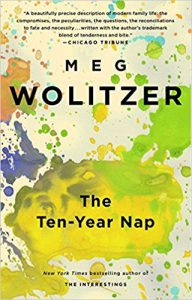The Ten-Year Nap, by Meg Wolitzer
The Ten-Year Nap
By Meg Wolitzer
Riverhead Books
Three Stars
Reviewed by Jessica Gribble
As one of the endorsements points out, Meg Wolitzer is a social observer of Tom Wolfe-ian status, and her writing style mimics his to a tee. The Ten-Year Nap includes both deliciously pointed observations and annoying, too-clever remarks. Despite the promise of this unflinching and sharp-eyed look at career women who return home to raise their children, I ended up disappointed.
Many women are ambivalent about leaving their hard-earned jobs to stay home with children. Is being a good mom the fulfillment, or an abrogation of, a woman’s dreams? The plot of this novel, which involves four New York friends—all stay-at-home moms—is a bit dull, by design. The most dramatic parts include a new friendship, an adopted daughter with a learning disability, an affair, a charity project, and an impromptu drive to camp. But this is where Wolitzer shines. She weaves these mundane events into something that feels real. Women go about their lives, struggling with their own frustrations and disappointments, and then meet up to talk everything over. They’re not always honest with each other. Their lives feel comfortable, but dull. They long for excitement, but wonder if they’ll ever have it again, or if they ever really had it when they were working. Men are at the edges of this stay-at-home world, and the women often point this out. Their husbands can’t really understand them, and they can no longer understand their husbands, toiling all day at jobs the women have given up. The dialogue is well written, and the poignant realizations are touching and pithy: “Someone said, ‘The children are everything,’ and there was a moment of quiet emotion, as each of them thought of their offspring, those idealized, miniaturized versions of themselves. Roberta, too, was made silent with reverence when she thought of Harry and Grace, the last of her really ambitious productions before her actual art had been stopped by some invisible force.”
Why, then, the disappointment? Wolitzer is careful to represent every point of view—too careful. Though the plot is full of the small events that make up real life, the characters fit neatly into every possible stereotype. Halfway through the book, I felt as though Wolitzer had written a list of every type of person who might care about the delicate balance of career versus parenthood, made up names for those people, and built a novel around them. The well-off married people. The married people worrying about money. The aggressive, perfect dad and son. The couple who couldn’t have their own children and settled for adoption. The Asian who’s good at math. The artist who no longer makes art. The couple who moves from the city to the suburbs and feels left out, even though the lawns are surely good for the children. Even the man who secretly wishes he could be a stay-at-home dad. Although it’s nice that Wolitzer occasionally introduces a woman from a different time period to contrast with current womanhood, even these characters fit neatly into the grand outline of types: The immigrant. The working mom whose daughters feel uncared for. The woman fulfilled by the admiration of her husband. The actress with only one role.
It’s okay that I found this book depressing. Real life is often depressing, and it’s often the job of the novel to show us how and why. People do feel trapped in their circumstances. But I would’ve preferred to miss a couple of perspectives on those circumstances in order for this book to feel less relentlessly planned.
